Some of the links in this post may be affiliate links.
There are some very obvious, and some NOT so obvious ways to tell the difference between a Pothos and a Philodendron. Once you read these tips, you will never wonder about it again!
There is one observation that I made that I have never seen anyone explain, so keep reading to find out what it is!
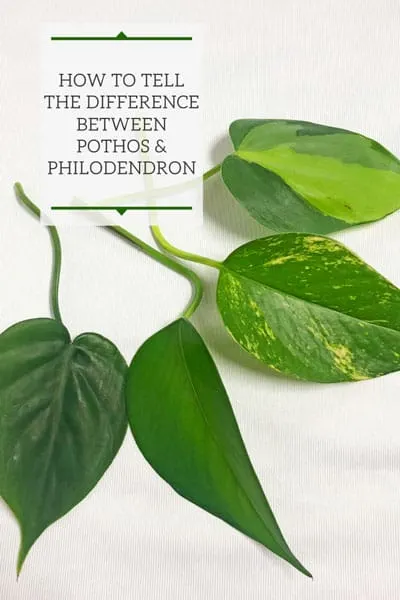
So many people have asked me what the difference is between a Pothos and a Philodendron, so I’ve written this post to set the record straight because there are quite a few differences!
Table of Contents
1. Pothos and Philodendron Taxonomy
I’m going to start on a very high level first to clear up some common confusion, and then I’ll get to some visual specifics that you can use.
Taxonomy is just a fancy word to describe the naming convention of plants by botanists. There is only one “official” botanical name for each plant, but there are MANY common names.
Simply put, Pothos and Philodendron are common names. What makes common names super confusing is that sometimes there are many common names for the same plant!
For example, what one person calls Pothos, another might call Devil’s Ivy. And what one person may call Snake Plant, another will call Mother in Law’s Tongue. This is why common names are so confusing.
One difference between Pothos and Philodendron is the genus. Pothos are classified as being any plants in the Epipremnum genus, whereas Philodendrons are well…in the Philodendron genus.
They ARE somewhat related though. Both are considered to be part of the aroid plant family (Araceae).
2. Shape of the Leaves
An easy way to tell the difference between Pothos and Philodendron is the shape of the leaves. Namely, at the widest part of the leaf.
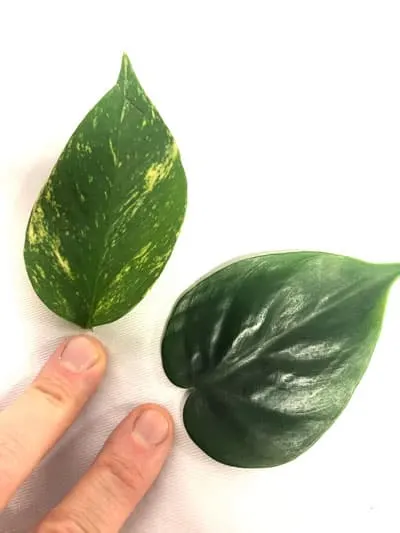
On the left side of the photo above is a Pothos leaf and the right side is a Heart Leaf Philodendron leaf. It’s called “heart leaf” for a reason!
Notice the pronounced curving and heart shape. The Pothos leaf lacks this characteristic.
3. Aerial Roots
Another way to tell the difference between Pothos and Philodendron is by looking at the aerial roots.
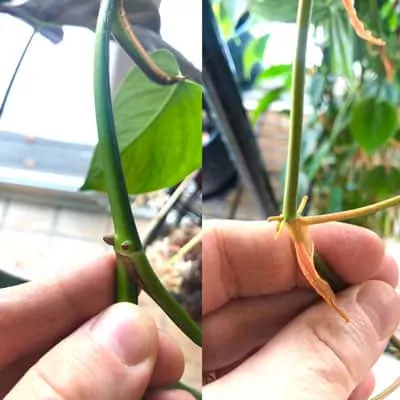
Take a look at the wider and stubbier pothos roots on the left, compared to the thinner aerial roots on the Heart Leaf Philodendron on the right.
Aerial roots will serve to help these plants climb in nature up trees. As they climb, the plants will start to develop larger foliage.
4. Sheath
One tell-tale sign of a Philodendron is the sheath that emerges from the nodes (where the leaf and petiole meets the vine). Notice the new sheath below between my forefinger and my middle finger.
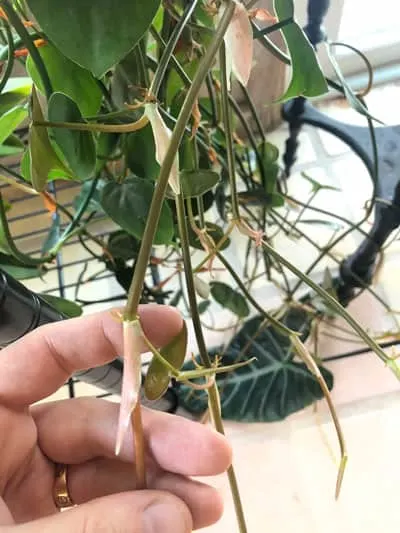
As the Philodendron grows, the sheaths will turn brown and papery, as you saw in the photo in the previous section on the right hand side of that picture.
Pothos will not have these sheathes. These sheaths are actually called cataphylls. They can photosynthesize as well, but also serve to protect the plant as its growing.
Here is a closer look at the cataphylls in 3 different stages on a heart leaf philodendron, all in one photo.
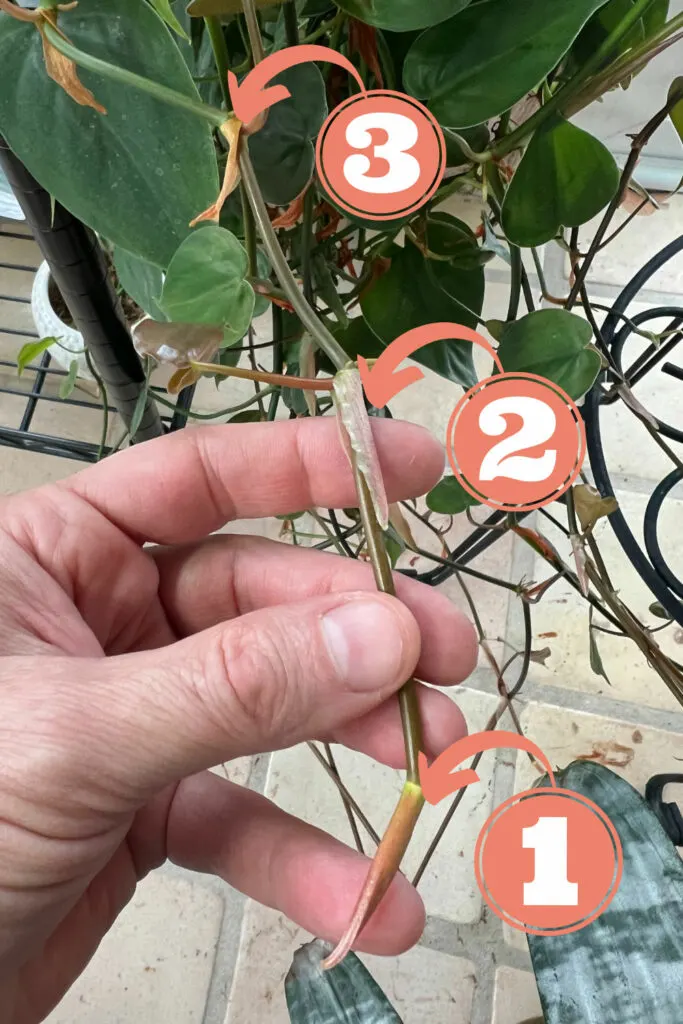
You can see the cataphylls at:
- The very tip of the vine
- After it has opened up and is still green
- After it has dried out and has become papery
On the other hand, you can see in the photo below that Pothos doesn’t have any cataphylls, and at the tip of the vine, the new leaf is starting to unfurl without a cataphyll.
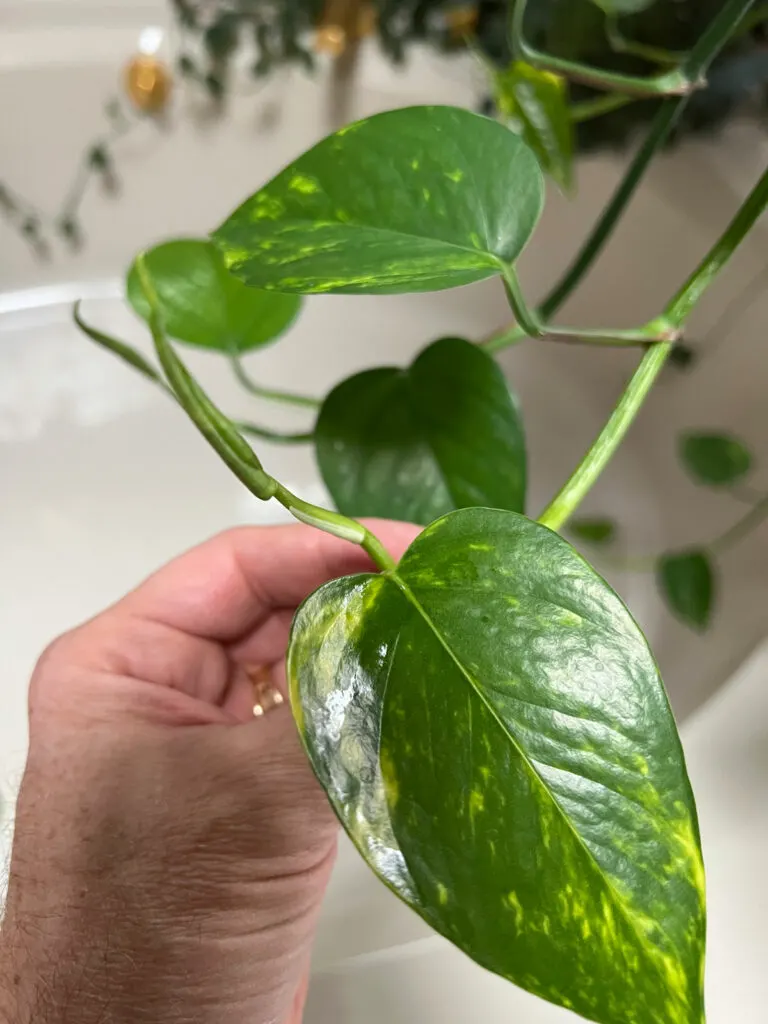
5. Petiole
This difference that I’m about to describe makes it really easy to tell the difference between Pothos and Philodendron.
Take a look at the photo below and look at the petiole. The petiole is what joins the leaf to the vine. On the left is the Pothos leaf and petiole, and on the right is the Philodendron leaf and petiole.
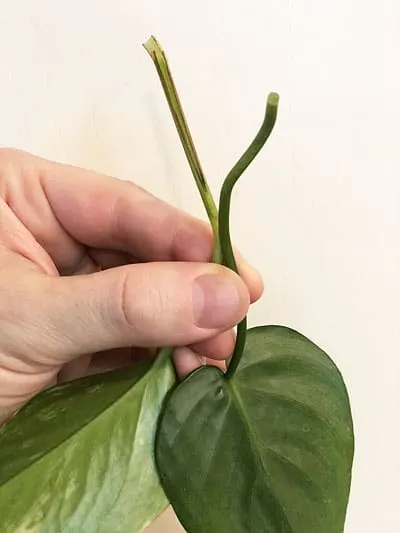
I noticed two main differences between the two. The Philodendron petiole on the right is very round and uniform. The Pothos petiole on the left has an indentation, is not completely round, and will eventually form two brown, papery edges.
This distinction makes it very easy to quickly tell the difference!
Types of Pothos and Philodendron
Of course there are MANY species and varieties of Pothos (Epipremnum genus) and Philodendron (Philodendron genus). Especially in the Philodendron genus, there is a huge variety of species and they look very different.
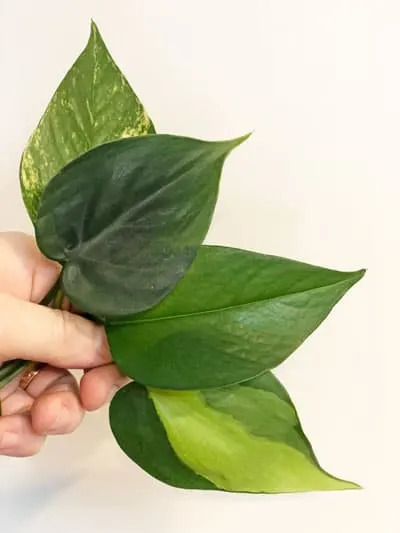
In the photo above, the top leaf and the second from the bottom came off of the same Golden Pothos plant. One leaf has variegation and the other doesn’t.
The second leaf from the top is commonly known as the Heart Leaf Philodendron. The bottom leaf is a closely related variety called Philodendron ‘Brasil.’
I’ve only covered some of the common vining forms that you will see for sale everywhere.
Let’s take a look at a few more kinds below so you can see all the beautiful varieties that are available.
POTHOS VARIETIES
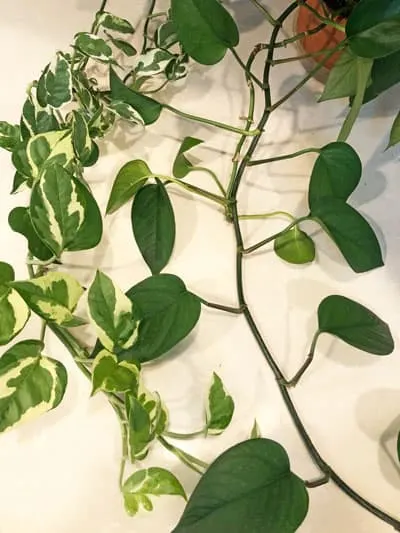
On the left is Pothos N’Joy, and on the right is the plain old golden pothos that you see everywhere. I love the beautiful variegation in the N’Joy.
There are others kinds of pothos though including ‘Marble Queen,’ ‘Pearls and Jade,’ ‘Jade,’ and ‘Cebu Blue.’ All of these have distinct colors and/or variegation in the leaves.
If you’d like to know how to care for these plants, I wrote separate blog posts on the care of the plain old pothos (Epipremnum aureum) as well as the stunning ‘Cebu Blue.’ I also talk about propagation in those posts.
Take a look at the stunning form and color of ‘Cebu Blue.’
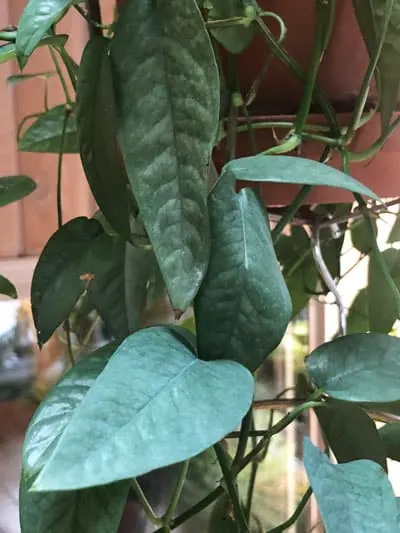
There is one type of Pothos that many people call Silver Pothos, but it actually is not a Pothos (Epipremnum genus).
The plant commonly known as Silver Pothos is in the Scindapsus genus and there is such a striking difference in the foliage that I won’t even comment on it!
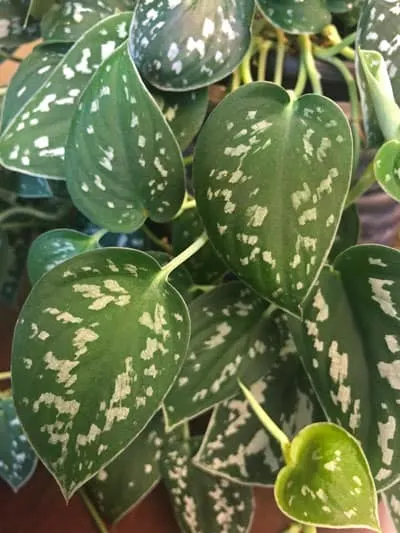
PHILODENDRON VARIETIES
The Philodendron genus is HUGE and there are many species.
Here are two types that I grow and that are commonly available.
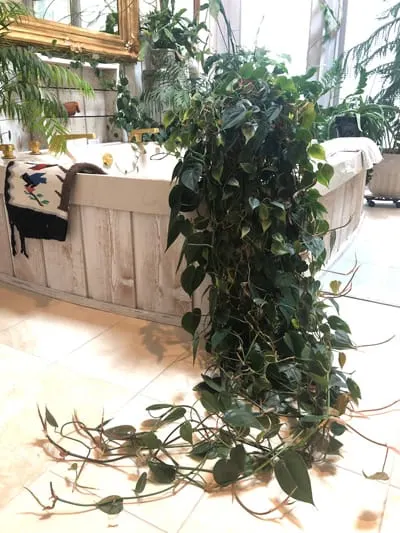
The photo above is my Heart Leaf Philodendron that I’ve had for many years. Isn’t she gorgeous?
And here is another type:
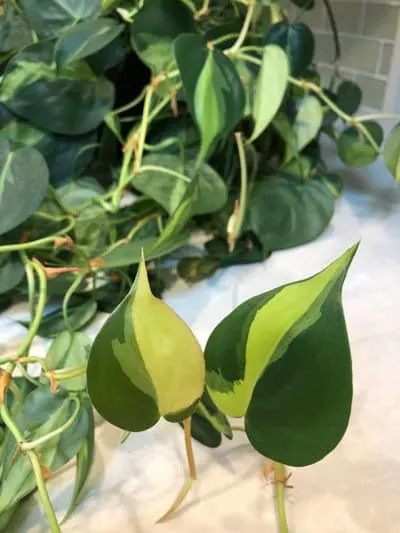
The photo above is Philodendron ‘Brasil’ with gorgeous leaf variegation.
Want to explore the various types of Philodendron? There is a huge variety available with different colored leaves, shapes and growing habits.
If you’re looking to explore varieties of Pothos to grow, check out my blog post:
Pothos Varieties: 15 Beautiful Types to Get Your Hands On
RELATED POSTS
Are you having a hard time propagating your Pothos?
If so, you will find the following post very helpful and be propagating in no time! Checking out Pothos Not Rooting? Top 10 Secrets Why You’re Failing.
COMMONLY ASKED QUESTIONS
Are Pothos and Philodendron the same thing?
Although they belong to the same plant family (Araceae, or the aroid plant family), they are different. Pothos generally refer to plants in the Epipremnum genus, while Philodendron plants belong to the Philodendron genus.
Can philodendron and pothos grow together?
Since they have very similar light, soil and moisture requirements, you can grow both of them together with no issues.
Why is pothos called devil’s ivy?
Pothos is called devil’s ivy because it is very difficult to kill and will survive and grow in many locations that are quite dim.
Is pothos a type of ivy?
Although pothos is also commonly called devil’s ivy, it is not the same kind of plant that we normally think of when we hear ivy. The common “ivy” is belongs in the Hedera genus which is in the Araliaceae plant family, whereas pothos is in the Araceae family.
Is Scindapsus a pothos?
Although they are both aroids (Araceae family), they belong to different genera. Although Scindapsus is commonly called Silver Pothos, Scindapsus belongs to the Scindapsus genus, whereas Pothos generally describes plants in the Epipremnum genus.
I hope you’ve enjoyed this post and hopefully by now you can easily tell the difference between a Pothos and a Philodendron!

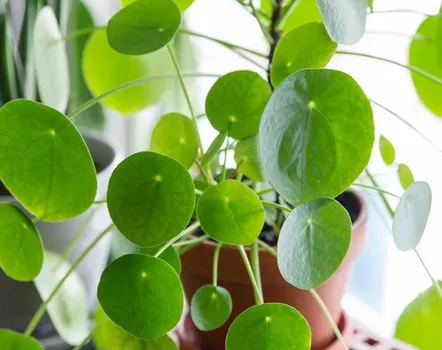
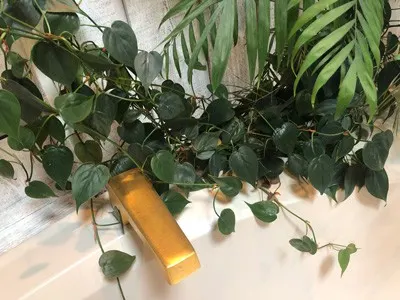
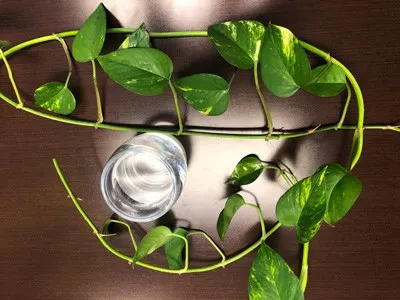
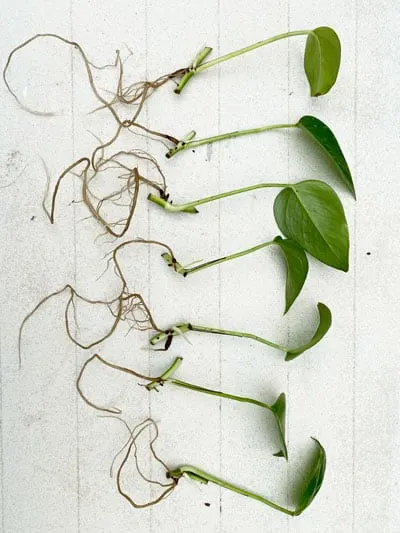
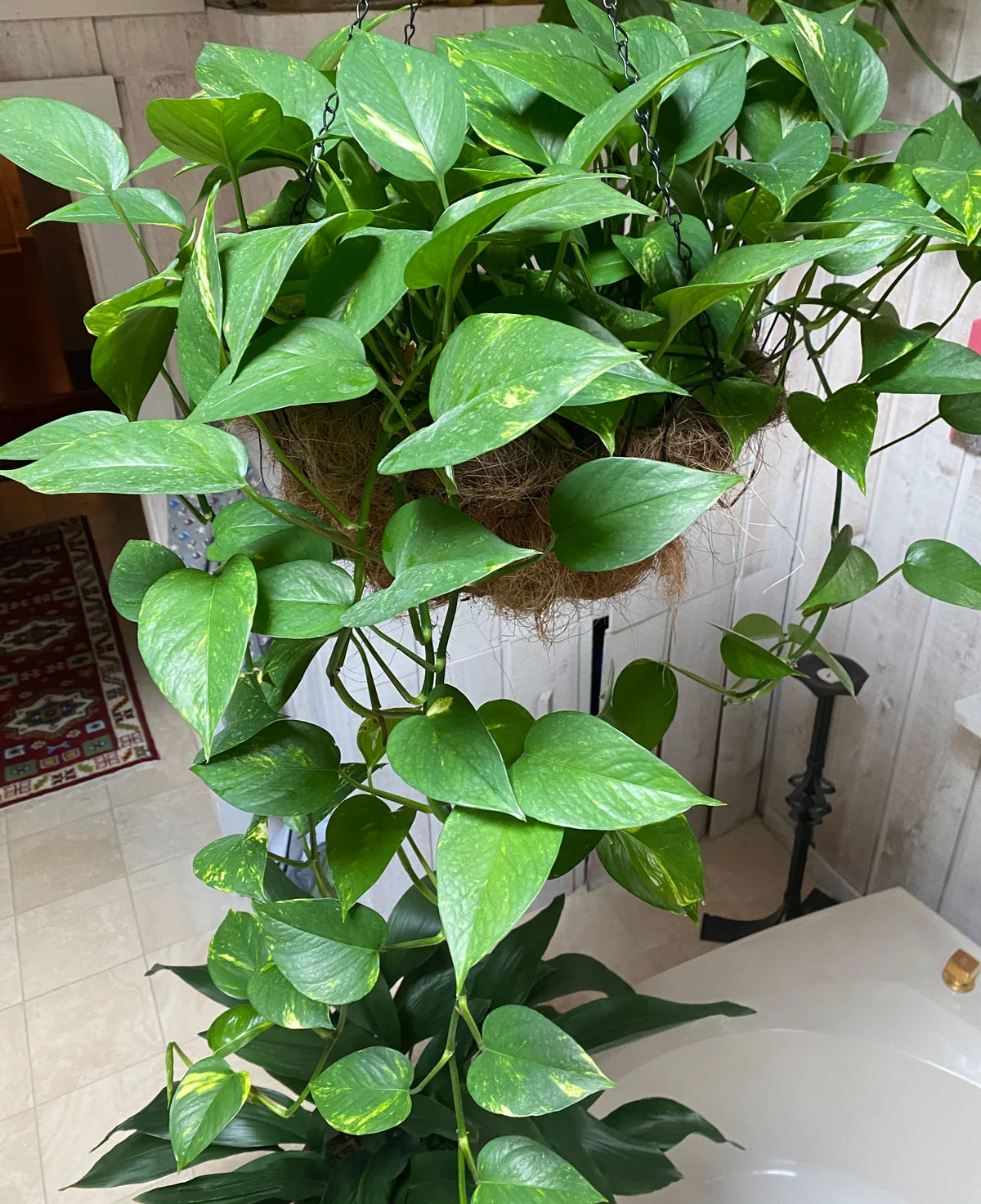
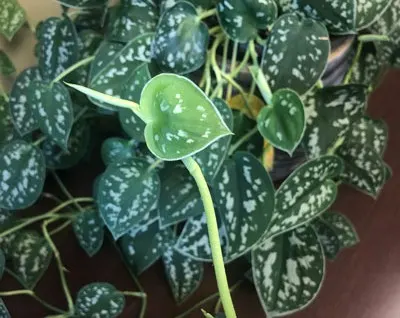
Kim
Friday 30th of August 2024
Thank you. I have a lot of plants and was raised with Philodendrons. Then my friend told me I have a Pothos. Now I have 2 and I wasn't sure if what I had was Pothos or philedendron. Turns out, I have one of each. :)
Raffaele Di Lallo
Sunday 1st of September 2024
You're very welcome Kim!
Rhonda
Sunday 29th of October 2023
This is very well written. I am new to the plant family however, I could understand this artical. thank you for the information.
Raffaele
Monday 6th of November 2023
I'm happy that you enjoyed it Rhonda!
ML Spitz
Saturday 15th of April 2023
Thank you so very much for explaining the difference between Pothos and Philodendron. Well done you!
Raffaele
Monday 17th of April 2023
You're very welcome! I'm glad you enjoyed my post :-)
Karla
Tuesday 7th of February 2023
Thank you for the detailed and easy explanation. It explained something to me. As soon as I read your explanation a light (all be it, kinda dim ) went on and I went to check all my pots, all are about half & half. The pathos seems to grow quicker.
Raffaele
Tuesday 7th of February 2023
You're very welcome!
Kate
Friday 27th of January 2023
Thank you. This was very helpful! I think even folks I have bought plants from in the past don't know the difference. I have purchased many being sold as Pothos and just walked through my house and "re-identified" them as Philodendrons! So funny.
Raffaele
Friday 27th of January 2023
Glad it was helpful Kate!